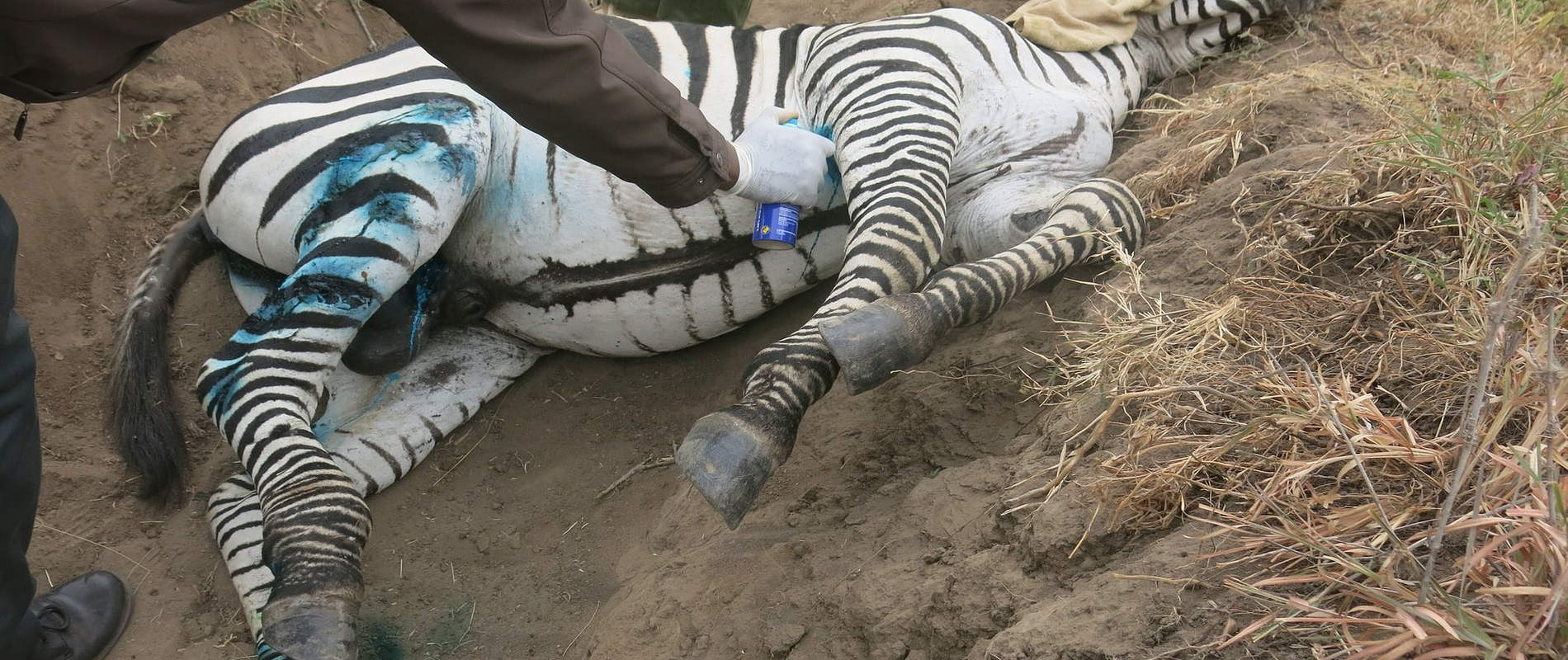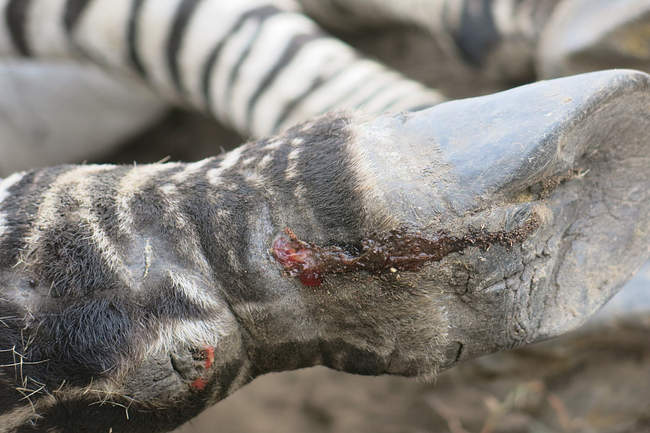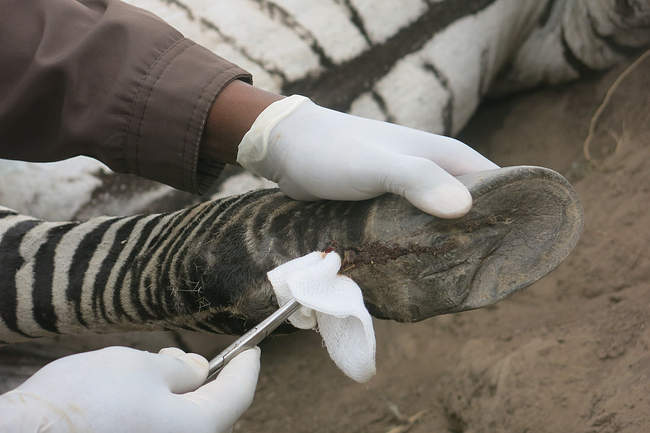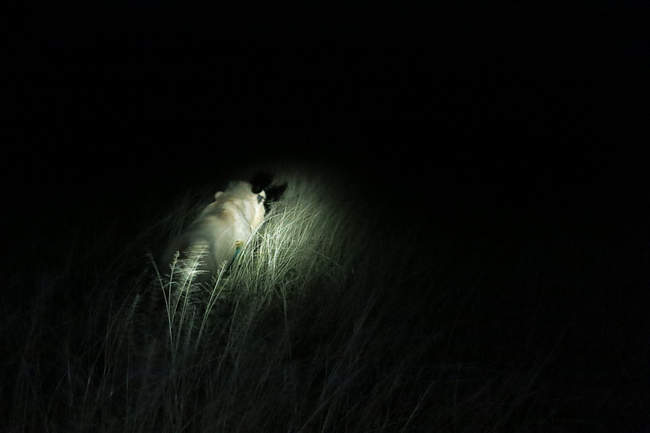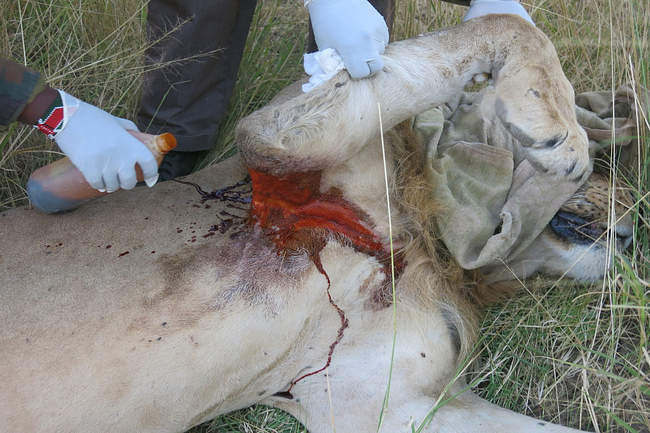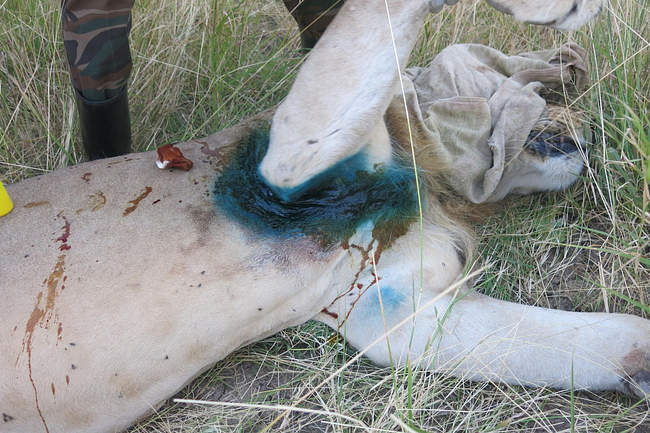Persistent cold dry weather conditions marked the beginning of the dry spell before the expected short rains later in the year. The vegetation is drying up fast especially outside the swamps and within community conservancies forcing the wildlife to inhabit the park area in large numbers for water and grazing.
CASE#1 SNARED ELEPHANT
Date: 09/07/2018
Species: Loxodonta africana
Sex: Male
Age: Adult
Location: Tsavo West
History: A report of a snared elephant was received from the Company Commander Tsavo West National Park. This was after failing to raise Tsavo East Vet Unit due to exigence of duties. The elephant had been spotted near Ngulia Bandas with a tight snare around its thorax dropping down past the hind limbs. The Amboseli Unit responded on the third day post primary sighting done. The second sighting was reported around the Kilaguni Serena Lodge which prompted our response.
Search: There was an assurance from the Coy Commander that the candidate would be within the area lastly spotted. As such the ground team started the search early in the morning while we travelled from Amboseli with plan to join them for search or treat if by the time we reached there they would have found the candidate. The candidate was searched for extensively and for the better part of the day moving from one ridge to the other. Challenges encountered were the thick thickets within the area and undulating terrain. This defeated the assumption that the candidate would easily be found. After an eight hours search the exercise was called off and planned to resume the next day. The search team was instructed to make prompt report when sighted so that a quick response would be initiated. We returned to Amboseli being on standby if found.
Prognosis: Guarded prognosis because an intervention was not possible. It is until an intervention is mounted from which the prognosis can be revised.
CASE#2 PROBLEMATIC LIONESS
Date: 10/07/2018
Species: Panthera leo
Sex: Female
Age: Adult
Location: Selenkei Conservancy
History: A persistent boma raider had been identified within the Selenkei Conservancy. It had predated on shoats numbering few tens nearing hundreds. The previous reported strike was of five bomas in a single night leading to six casualties. This was confirmed by both Lion Guardian and Big Life Foundation. A decision to collar the problem lion was reached so that it could be effectively monitored and when near bomas a depredation would be mounted to repulse it away from impending raid. We set out for the exercise.
Search and attempted darting: After the previous night raids the lioness had been chased away to the nearby thickets, away from the bomas. It is in this area that the search was mounted with view of enticing it to the call backs to effect darting. A dart composing of 450mgs Ketamine and 6mgs Medetomidine was prepared in three centiliter dart charged to Dan-Inject rifle.
The exercise was collectively mounted in company of Big Life Foundation area Unit, area Lion Guardians, the area community Chairman and area KWS Problematic Area Control Unit. We drove in one car leaving behind two other cars up at the hiding area. This was around night fall. Using rope we tied the bait tightly to the bark of a tree and parked the vehicle strategically so that the darting would be effected once the lioness was lured into the bait area.
Call backs begun to be played one after the other with an interval of fifteen minutes. These consisted of calf distress calls, hyenas feeding, zebra and buffalo distress calls. The candidate was known to be shy and cunning and that difficulties to lure her were foreseen. After two hours she failed to turn up. This prompted the exercise to be called off pending for another trial day. Lion Guardians together with Big Life Foundation Units were tasked to be on the lookout and report appropriately for another attempt once sighted or following a raid.
Prognosis: Guarded because the community was expressing dissatisfaction threatening to spear the lioness.
CASE#3 ZEBRA TREATMENT
Date of death: 12/07/2017
Species: Aquus burchelli
Sex: Male
Age: Adult
Location: Maazoni Ranch
History: While on a mission to desnare a giraffe at the ranch having been called by Senior Warden Machakos KWS Station, we bumped into a severe lame zebra which could not bear weight on the right hind limb. We immediately set to intervene. The male zebra was standing motionless under the shade of a small acacia tree carrying the leg high up. There were another two males in nearby thickets resting. Darting was necessary in order to carry out a thorough examination.

Immobilization, examination and treatment: It was sedated using 4mgs Etorphine and 70mgs Azaperone in 1.5cc dart. It was darted on the right rump and moved a little distance and was fully sedated in five minutes assuming left lateral recumbence. It was blindfolded and examined. Skin tears were all over especially on the hind limbs and were granulating with different stages of epithelialization. The said limb had a penetrating wound just above the coronet discharging reddish pus. It seemed it was recovering from a previous traumatic snare wound which was causing soreness of the fetlock. It had begun to shed off weight as depicted by bony prominence in comparison with counterparts. Other granulating wounds seemed to have been caused by territorial bites from other stallion(s).
The granulating wounds were sprayed topically with Tetracycline wound spray. The discharging wound was splashed with Hydrogen Peroxide after probing using forceps for any foreign object. It was swabbed dry followed with topical application of Tincture of Iodine. Then Tetracycline wound spray was liberally applied. It was injected into muscles at different sites with Tetracycline 20000mgs and 50ml Multivitamin. Finally Flunixine Meglumine 400mgs was injected into the muscles as anti-inflammatory.

Reversal and prognosis: A mixture of 6mgs Diprenorphine and 20mgs Naltrexone was injected into jugular vein with the animal fully up in two minutes. It trotted away slowly. Prognosis for full recovery is good.
CASE#4 SNARED GIRAFFE
Date: 12/07/2018
Species: Maasai Giraffe
Sex: Male
Age: Adult
Location: Maazoni Lodge
History: Machakos KWS Station Senior Warden reported a snared maasai giraffe at Maazoni Ranch to the KWS Head Vet who eventually tasked the Amboseli Vet Unit to act. It was said to have a snare around the fetlock dragging behind about four meters. It was tight though it had not caused traumatic wound. We planned an intervention on the following day.
Search: Together with Maazoni rangers and KWS Station PAC Unit, we mounted a search thorough the entire ranch incorporating the nearby private owned expansive farms. We encountered all the giraffes though in different groups. It was after six hours search that we encountered the last eleven member group to make a total of forty that we identified the snared candidate.

After getting closer we established that the candidate had dropped off the snare wire leaving abrasion mark all-round the snared fetlock. It was just on the skin surface and there was no resultant traumatic wound. It was ambulating normally and keeping pace with the rest of the group members. A conclusion was reached to not engage in darting exercise because there was no compelling reason to do so. The Maazoni rangers were instructed to keep monitoring and report if they note any negative change to the abrasion area such as wound development.
Prognosis: Prognosis for full recovery is good.
Our Mobile Vet Units are in the field every day saving wild lives
CASE#5 LION DESNARING
Date: 16/07/2018
Species: Panthera Leo
Sex: Male
Age: Adult
Location: Amboseli National Park
History: The tour guide, Joel, of Zebra Plain Mara Camp based in Masai Mara while navigating within Amboseli with visitors spotted a snared lion at around 1700hours. The snare was a winch wire which was under his right arm, at the armpit, causing extensive skin abrasion due to friction and going round the neck on the left side. The cat was walking hesitantly with a lot of pain.
He quickly called the Amboseli customer care who quickly gave Joel the Mobile Vet Number. The vet was called and quickly requested Joel to keep a watch so that we don’t lose sight of him. We dashed to the location where we found Joel and his visitors patiently waiting for us to show the snared lion.

Immobilization, examination and treatment: It was tracked down through the tall grass and after spotting it walking, dart was quickly made using 450mgs Ketamine and 6mgs Medetomidine. It was neared using vehicle. It laid down after spotting the vehicle on its trail. Without hesitation it was darted on the left thigh which startled it causing it to run off, only to about fifteen meters away, as the drugs started to take effect and it slowed down.
It was completely immobilized assuming left lateral recumbence in fifteen minutes. By this time it was 1830hours. After probing to make sure it was fully sedated, it was blindfolded ready for desnaring. The snare wire was severed using wire cutters and carefully taken off the animal. The wounds were superficial and oozing serum. They were cleaned using Tincture of iodine at the armpit and liberally sprayed with Tetracycline wound spray. It was injected with 200mgs Flunixin Meglumine and 4000mgs Amoxycillin into different muscle sites.
Reversal and prognosis: We kept monitoring the lion and after seventy five minutes post darting it was revived using 20mgs Atipamezole injected into its right thigh muscles. Ear reflex begun after fifteen minutes and at the twentieth minute post revival it walked away into the nearby elephant grass. We left it totally aware of its’ surrounding. Prognosis for full recovery is good.
Acknowledgement
Report by KWS Vet Dr Ndambiri Ephantus. We humbly acknowledge the funding of David Sheldrick Wildlife Trust which enables the unit to mount quick responses whenever called. Also the help from the area community, KWS managers, NGOs and Conservancies cannot be forgotten. It is through these formidable relations that all the above has been achieved.
